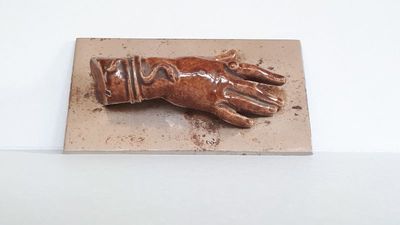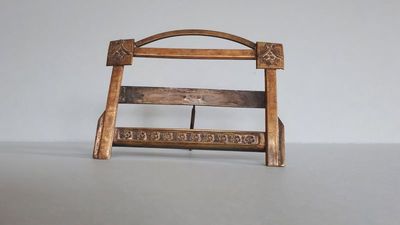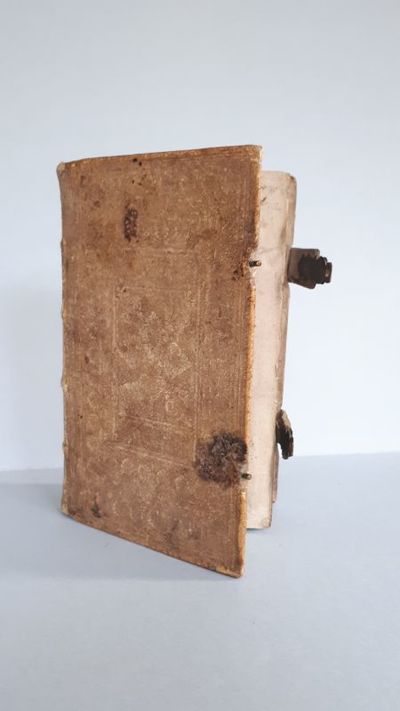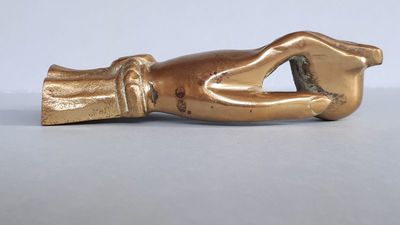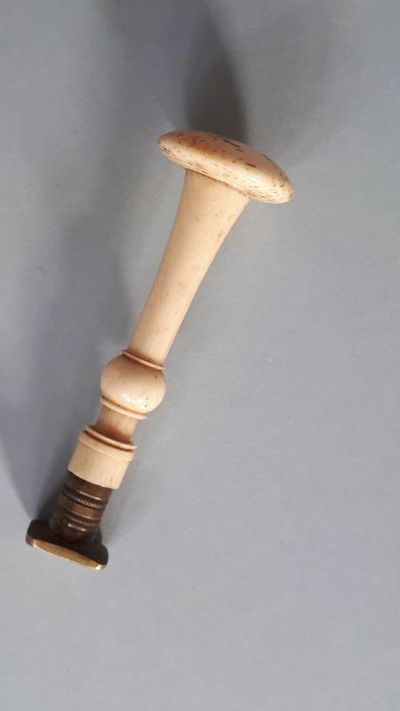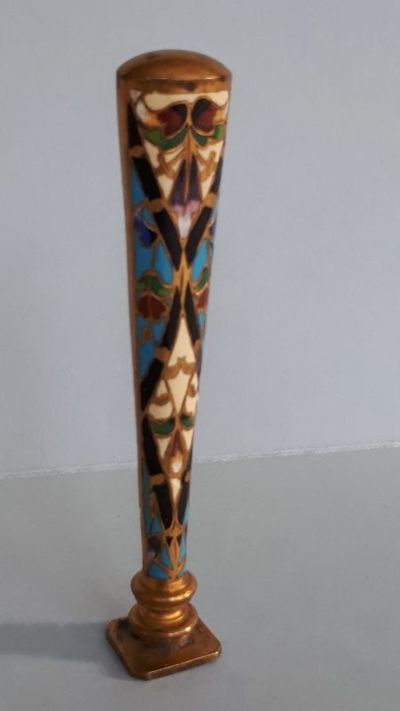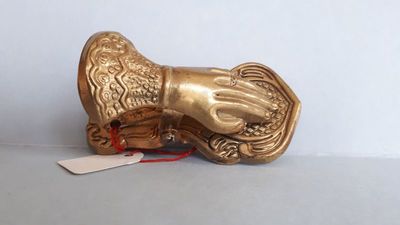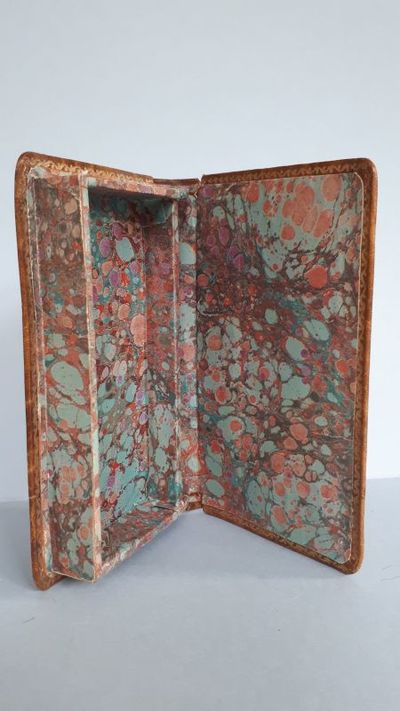The Tale of Peter Rabbit.
14,1 x 10,8 cm. 85 Seiten, 26 Farbtafeln (und das farbige Frontispiez). Original Pappband mit montierter, farbiger Deckelillustration. Geringe Gebrauchsspuren, Rückendeckel mit alt geklebtem Deckelpapierabrieb, siehe scan. Frühe Ausgabe von Potters beliebtestem und beständigstem Kinderbuch. Potter, Beatrix. The Tale of Peter Rabbit. London, Frederick Warne & Co. and New York. 14.1 x 10.8 cm. 85 pages, 26 color plates (and the colored frontispiece). Original cardboard volume with mounted, colored cover illustration. Minor signs of wear, back cover with old glued cover paper abrasion, see scan. Early edition of Potter's most popular and enduring children's book. Sprache: englisch.
More from Stader Kunst-Buch-Kabinett
New Picture of London; or a view of political, religious, medical, literary, municipal, commericial, and moral state of the British Metropolis; presenting a luminous guide to the stranger, on all subjects connected with general information, business, or amusement. To which are subjoined, a description of environs, and a plan for viewing London in eight days.
New edition, carefully revised. 14,4 x 9,3 cm. VII, 474 Seiten. Mit gestochenem Frontispiz und 111 Ansichten auf Stahlstichtafeln, 2 gestochenen Faltkarten und 1 gestochenem Faltplan von London (45 x 58 cm). Lederband der Zeit (vielleicht Verlagseinband) mit goldgeprägtem Rücken- und Deckeltitel. Berieben und bestossen, unteres Kapitale eingerissen. Leigh, S. New Picture of London; or a view of political, religious, medical, literary, municipal, commercial, and moral state of the British Metropolis; presenting a luminous guide to the stranger, on all subjects connected with general information, business, or amusement. To which are subjoined, a description of environments, and a plan for viewing London in eight days. New edition, carefully revised. London, London, printed for Leigh and Son, 421, Strand; and Baldwin and Cradock, Paternoster-row; printed by William Clowes, Duke Street, Lambeth. MDCCCXXXIV [1834]. 14.4 x 9.3 cm. VII, 474 pages. With engraved frontispiece and 111 views on steel engraving plates, 2 engraved folding maps and 1 engraved folding plan of London (45 x 58 cm). Leather binding of the time (perhaps publisher's binding) with gold-embossed spine and cover title. Rubbed and chipped, lower capital torn. Sprache: englisch.The Picture of London, for 1810; being a correct guide to all the curiosities, amusements, exhibitions, public establishments, and remarkable objects, in and near London, with a collection of appropriate tabels, two large maps, and several other engravings.
The eleventh edition. 14 x 9,2 cm. XII, 456, 35 Seiten. Mit 1 gefaltetem Stahlstich-Frontispiz, 4 gestochenen Faltplänen und 1 gefaltete Kupferkarte sowie ein gefaltete Tabelle. Lederband der Zeit mir goldgeprägtem Deckeltitel (etwas fleckig, Buchrücken aufgehellt). Reiseführer mit Beiträgen zur Geschichte, Statistik, Militär, Kunst und Künstlern, Literatur und Buchhandel, Kultur, Unterhaltung, öffentliche Gebäude aller Art, Geografie. Mit einer sehr dekorativen Stadtansicht, einer Umgebungskarte von Hartford bis Surrey/Kent sowie von Windsor bis Woolwich reichend, einem Stadtplan "London with its modern improvements (Format 23 x 58 cm), sowie Plänen der East & West India Docks, von Westminster, der "curiosities of London" sowie einer Ansicht >Covent Garden Theatre, built 1809Covent Garden Theater, built 1809< (as a frontispiece). The plates are slightly browned and brown-stained, minor tears at the edges. Sprache: englisch.Thamar.
24,9 x 16,8 cm. Schwarzer Original-Halblederband (Leder am Rücken brüchig und mit Fehlstellen) und goldgeprägtem Rückentitel. Exemplar 114 von 150 der Vorzugsausgabe in Halbleder gebunden (Gesamtauflage 250 Exemplare). Literatur: Potempa D 8.7. - Felix Guggenheim und Ernst Gottlieb gründeten 1942 die >Pazifische PresseBrentano s [New York]Brentano's [New York]Die Anklageschrift des Inhabers des Verlages Eugen Diederichs in Jena, Herrn Eugen Diederichs, Jena.
21,8 x 18,1 cm. 1 Blatt, 11 Seiten. Späterer Pappband (berieben, Ecken und Kanten berieben und bestossen). Ein weiteres Exemplar für mich nicht nachweisbar. - Das Typoskript stellt eine Art Weckruf an Presse und Leserschaft bezüglich Wladyslaw Reymonts vierteiligem Romanzyklus "Die politischen Bauern" dar. Die deutsche Erstausgabe wurde in der Übersetzung von Jean Paul d Ardeschah im Jahr 1912 im Diederichs-Verlag verlegt. Nach der Meinung des Verfassers verdient das Werk mehr Aufmerksamkeit, als ihm zur Zeit seiner Veröffentlichung zukommt. "Es geht nicht jedes gute Buch. Aber viele Menschen wissen nicht, dass es Bücher gibt, die zu kennen ein Erlebnis für sie wäre, von denen sie aber nichts hören und nichts sehen. [.] Ja, ich warte auf sämtliche Blätter in Breslau, Posen, Königsberg, dass sie ihren Lesern erzählen, ein Werk der Weltliteratur sei ihnen endlich zugänglich, das ihnen das Seelenleben ihrer polnischen Mitbürger so nahe bringe, wie es eben nur die Kunst tun könne und nicht ein politischer Leitartikel." - Es folgen Auszüge aus Zeitungsartikeln, die das Potential des Romans erkannt haben. - Reymonts Werk erschien erstmals 1902-1908 als vielteiliger Fortsetzungsroman in der Warschauer Wochenschrift "Tygodnik Illustrowany", die erste Buchausgabe folgte in vier Bänden 1904-1909. Das Buch stellt ein facettenreiches Porträt der ländlichen Gemeinschaft in den vier Jahreszeiten dar. Der Autor wurde 1924 explizit für den Roman mit dem Nobelpreis für Literatur geehrt. Reymont, Wladyslaw. - Diederichs, Eugene. The indictment of the owner of the Eugen Diederichs publishing house in Jena, Mr. Eugen Diederichs, Jena. October 1913. 21.8 x 18.1 cm. 1 sheet, 11 pages. Later cardboard band (rubbed, corners and edges rubbed and bumped). I cannot find another copy. - The typescript represents a kind of wake-up call to the press and readers regarding Wladyslaw Reymont's four-part novel cycle "The Political Peasants". The first German edition was published in 1912 by Diederichs-Verlag in a translation by Jean Paul d'Ardeschah. In the author's opinion the work deserves more attention than it receives at the time of its publication. "Not every good book will work. But many people don't know that there are books that would be an experience for them to know, but about which they hear nothing and see nothing. [.] Yes, I'm waiting for all the pages in Breslau, Posen, Königsberg, that they tell their readers that a work of world literature is finally accessible to them, which brings them as close to the mental life of their fellow Polish citizens as only art can do and not a political editorial." - The following are excerpts from newspaper articles that recognized the potential of the novel. - Reymont's work first appeared in 1902-1908 as a multi-part serial novel in the Warsaw weekly "Tygodnik Illustrowany", the first book edition followed in four volumes 1904-1909. The book represents a multifaceted portrait of the rural community in the four seasons. The author was honored with the Nobel Prize for Literature in 1924 specifically for the novel. Sprache: deutsch.Das Plakat. 11. Jahrgang Heft 10. Sonderheft : Der Film, Oktober 1920.
28,6 x 22,6 cm. VIII, 1, 443-494, IX-XII. Seiten. Farbige Original-Broschur (Ecken und Kanten berieben und bestossen, untere rechte Ecken mit Knicke). Illustriert mit rund 100 s/w-Abbildungen von Filmplakaten und Filmwerbung, 14 ganzseitigen Farbtafeln (darunter Plakatmotive von den Künstlern Otto Arpke und Josef Fenneker. - Abbildungen der Plakate zu den Filmen "Gespensterschiff", "Der weiße Pfau", "Der Galeerensträfling", "Madame Dubarry", "Totentanz", "Casanova", "Die Prostitution") sowie 2 Farbpostkarten zum Film "Alraune und der Golem". Aufsätze : "Das deutsche Filmplakat" (von Dr. Walter F. Schubert), "Film-Reklame und Reklame-Film" (von Dr. Herbert Tannenbaum), "Kunst und Suggestion" (von Karl Fleischhack) sowie "Lichtbild und Umrahmung" (von Rudolf Bleistein). Textbeiträge über den Film als Kulturträger und Werbemittel, Filmreform und Filmliga, Presse und Reklame, Filmprüfungsstelle - Plakatverbote - Nacktheiten. - "DAS PLAKAT war eine bemerkenswert aufwändig ausgestattete Zeitschrift des Vereins der Plakatfreunde e. V. für Kunst in der Reklame. Sachs, Hans (editor); Reckendorf, Hermann (editor). DAS PLAKAT. 11th year, issue 10. Special issue: The Film, October 1920. Berlin-Charlottenburg. Publishing house "The Poster". 28.6 x 22.6 cm. VIII, 1, 443-494, IX-XII. Pages. Colored original brochure (corners and edges rubbed and bumped, lower right corners with creases). Illustrated with around 100 b/w illustrations of film posters and film advertising, 14 full-page color plates (including poster motifs by the artists Otto Arpke and Josef Fenneker. - Illustrations of the posters for the films "Ghost Ship", "The White Peacock", "The Galley Convict" , "Madame Dubarry", "Dance of Death", "Casanova", "Prostitution") and 2 color postcards from the film "Alraune and the Golem". Essays: "The German Film Poster" (by Dr. Walter F. Schubert), "Film Advertising and Advertising Film" (by Dr. Herbert Tannenbaum), "Art and Suggestion" (by Karl Fleischhack) and "Photography and Framing" (by Rudolf Bleistein). Text contributions about film as a cultural medium and advertising medium, film reform and film league, press and advertising, film review board - poster bans - nudity. - "DAS PLAKAT was a remarkably equipped magazine from the Poster Friends Association for art in advertising. Sprache: deutsch.Der Malik. Eine Kaisergeschichte mit Bildern und Zeichnungen von der Else Lasker-Schüler. Eins von 100 nummerierten und im Druckvermerk signierten Exemplaren der Vorzugsausgabe. Mit einer gedruckten Widmung an Franz Marc.
Erste Ausgabe. 25 x 18 cm. 102 Seiten, 5 Farbtafeln und 24 Illustrationen. Olivgrüner Halblederband mit goldgeprägtem Rückenschild. Rücken etwas fleckig, sauberer und breitrandiger Druck auf festen Büttenpapier. Literatur: Raabe 182, 12-4. - Wilpert/G. 13. - Feilchenfeldt/Brandis 119.IV.0. Special edition. Lasker-Schüler, Else. Der Malik. A history of the emperor with pictures and drawings by Else Lasker-Schule. One of 100 numbered and signed copies of the special edition. With a printed dedication to Franz Marc. First edition. Berlin, Paul Cassirer Verlag, 1919. 25 x 18 cm. 102 pages, 5 color plates and 24 illustrations. Olive green half leather strap with gold embossed back label. Spine slightly stained, clean and wide-margined print on sturdy handmade paper. Literature: Raabe 182, 12-4. - Wilpert/G. 13. - Feilchenfeldt/Brandis 119.IV.0. Sprache: deutsch.ARBEIT. 12 Linolschnitte von A. Wöhlermann und H. Starnberger. Vorwort von H. Grasemann.
29 x 22,4 cm. (28) Seiten, 12 Tafeln mit den Linolschnitten. Eine Seite Text von Hermann Grasemann. Die Linolschnitte nicht signiert. Illustrierte Original-Klammerheftung (Randeinrisse; Rückendeckel mit alten Farbflecken). Exemplar mit starken Gebrauchs- und Altersspuren. Für mich nicht bibliographisch nachweisbar! ARBEIT. [WORK]. 12 linocuts by A. Wöhlermann and H. Starnberger. Foreword by H. Grasemann. Berlin-Britz, publishing house of the Werkgemeinschaft "Das Werden" by E. Baumgarten, Pintschallee 37. Print: Hausdorf and Blümel, Neukölln. 1925. 29 x 22.4 cm. (28) pages, 12 plates with the linocuts. One page of text by Hermann Grasemann. The linocuts are not signed. Illustrated original staple binding (margin tears; back cover with old paint stains). Copy with strong signs of use and age. Not bibliographically verifiable for me! Sprache: deutsch.Mehrseitiger Werbe-Prospekt für die Firma Dr. J. Morisse u. Co. Elberfeld.
21,2 x 13,2 cm. (6) Seiten, gefaltet. Im Druck signiert und datiert, Juni 1920. Dr. J. Morisse u. Co. war ein Hersteller feinster Parfüme mit Sitz in [Wuppertal-] Elberfeld. Kampmann war als Werbegrafiker für diese Firma mehrmals tätig. - Abbildung im Kampmann-Heft DAS PLAKAT, 1921, Seite 326. Kampmann, Walter (1887-1945). Small advertising brochure for the company Dr. J. Morisse and Co. Elberfeld. 21.2 x 13.2 cm. (6) pages, folded as issued. Signed and dated in the print, June 1920. Dr. J. Morisse u. Co. was a manufacturer of the finest de luxe perfumes located in [Wuppertal-] Elberfeld. Kampmann worked as a commercial artist for this company several times. - See illustration in the Kampmann booklet issued in: DAS PLAKAT, 1921, page 326. Sprache: deutsch.Bergen-Belsen. Kriegsgefangenenlager 1940-1945. Konzentrationslager 1943-1945. Displaced Persons Camp 1945-1950. Katalog zur Dauerausstellung.
26,7 x 20,1 cm. 383 Seiten, Abbildungen. Original-Broschur, gutes Exemplar. Bergen-Belsen. Prisoner of war camp 1940-1945. Concentration camps 1943-1945. Displaced Persons Camp 1945-1950. Catalog for the permanent exhibition. Wallstein Verlag, 26.7 x 20.1 cm. 383 pages, illustrations. Original brochure, good copy. Sprache: deutsch.Das Trunkene Schiff Ballade von Jean Arthur Rimaud. Deutsche Nachdichtung von Paul Zech. Holzschnitte von Willi Geissler.
27 x 18,9 cm. 22 Seiten, 1 Seite Anzeige. Titelholzschnitt (wiederholt auf dem Vorderdeckel) und 7 ganzseitige Original-Holzschnitte von Willi Geissler. Original Fadenheftung, geringe Gebrauchsspuren. Eins von 50 nummerierten Exemplaren der Vorzugsausgabe auf Bütten, im Druckvermerk vom Künstler signiert. >Die Schacht-Maler, 2. HeftThe Schacht Painters, 2nd issue- $496
- $496
Contemporary Prints. Buchholz Gallery Curt Valentin, December 4-29, 1945. Exhibition 32 East 57th Street New York.
17,3 x 12,4 cm, (6) Seiten, 21 schwarz-weiss Abbildungen der Arbeiten, illustrierte Original-Klammerheftung, Katalog mit abgebildeten Arbeiten von European Printmakers Matisse, Laurens, E. L. Kirchner, Braque, Picasso, Lipchitz, Hayter, Miró, Klee, Rouault, Masson, Beckmann, Villon, Chagall, Nolde, Matisse, Maillol, Munch, Lehmbruch, Feininger, Kollwitz. Mit einem Verzeichnis der von der Galerie herausgegebenen Prints (Drewes, Feininger, Hayter, Masson, Pickhardt, Sintenis). Einband fleckig, siehe die Abbildung. - Beiliegend ein seltenes Verzeichnis der "Publications" der Galerie. Contemporary prints. Buchholz Gallery Curt Valentin, December 4-29, 1945. Exhibition 32 East 57th Street New York. New York, 1945. 17.3 x 12.4 cm, (6) pages, 21 black and white images of the works, illustrated original staples binding, catalog with illustrated works by European printmakers Matisse, Laurens, E. L. Kirchner, Braque, Picasso, Lipchitz, Hayter, Miró, Klee, Rouault, Masson, Beckmann, Villon, Chagall, Nolde, Matisse, Maillol, Munch, Lehmbruch, Feininger, Kollwitz. With a list of the prints published by the gallery (Drewes, Feininger, Hayter, Masson, Pickhardt, Sintenis). Cover stained, see picture. - Enclosed is a rare list of the gallery's "Publications". Sprache: englisch.- $33
- $33
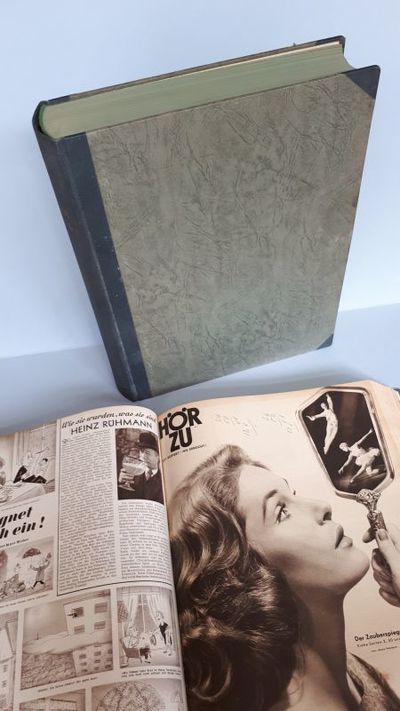
HÖR ZU ! HÖRZU! Die Illustrierte Rundfunk- und Fernsehzeitung. Norddeutsche Ausgabe Hamburg.
1956. Heft 1 bis 52 [Alles]. 2 Bände. Hamburg-Stuttgart-Köln-Berlin. Hammerich & Lesser Verlag G.m.b.H., 1956. 35,8 x 28 cm. Je Heft ca. 48 bis 65 bzw. 70 Seiten, zahlreiche schwarz-weiss Abbildungen. Anzeigenseiten. Titelblätter teilweise in Farbe. Mehrfarbendruck einiger Bildbeiträge. Sehr guter Erhaltungszustand, wenige Randeinrisse (manche alt geklebt), Flecken und handschriftliche Kurznotizen. Einzigartiger Querschnitt duch die Zeit und die Gesellschaft. U. a. Olympiade 1956 in Cortina d´Ampezzo und Melbourne, Vermißtensuchdienst, Klatsch und Tratsch, Fortsetzungsroman, Rätsel, Bildergeschichten, Mode, Werbung, Berichte über Stars und Sternchen. HÖR ZU! The illustrated radio and television newspaper. North German edition Hamburg. Complete 1956 year in two privately bound half-volumes. Issues 1 to 52 [All]. 2 volumes. Hamburg-Stuttgart-Cologne-Berlin. Hammerich & Lesser Verlag G.m.b.H., 1956. 35.8 x 28 cm. Each issue 48 to 65 or 70 pages, numerous black and white images. Ad pages. Title pages partly in color. Very good condition, few tears in the edge (some old glued), stains and short handwritten notes. 1956 Olympics in Cortina d'Ampezzo and Melbourne, missing person search service, gossip, serial novels, puzzles, picture stories, fashion, advertising, reports on stars and starlets.- $304
- $304
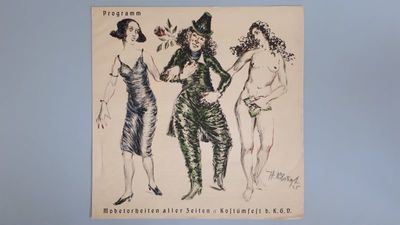
Programmheft: Programm Modetorheiten aller Zeiten // Kostümfest d. K.G.V.
Ohnsorg-Theater. Klugt, Hugo Prolog gesprochen von Elsa Klugt. 37,5 x 37,8 cm. (6) Seiten, einschließlich Umschlag, farbige Original-Lithographie auf der Vorderseite (im Stein von Klugt signiert und datiert). Kleinere Randeinrisse, sonst ein schönes Exemplar. Äusserst selten! Ohnsorg Theater. Smart, Hugo. Program booklet: program fashion follies of all time // costume party d. K.G.V. Low German stage (director: Dr. Richard Ohnsorg) on 4. February 4, 1925. "Dat lütte Rumenken" Een funny Spill ut Hamborgs ole Tiden in 3 acts by Otto Franz Grund. Speelbaas: Bruno Wolberts, intermediate music by Walter Bullerdiek. Actors: Hans Möhring, Magda Bäumken, Käthe Alving, Kurt Wieske, Ludwig Schröder, Hermann Möller, Rud. Beiswanger, Bruno Wolberts. Prologue spoken by Elsa Klugt. 37.5 x 37.8 cm. (6) Pages, including cover, original colored lithograph on the front (signed and dated in the stone by Klugt). Smaller tears in the margins, otherwise a fine copy. Extremely rare!- $317
- $317
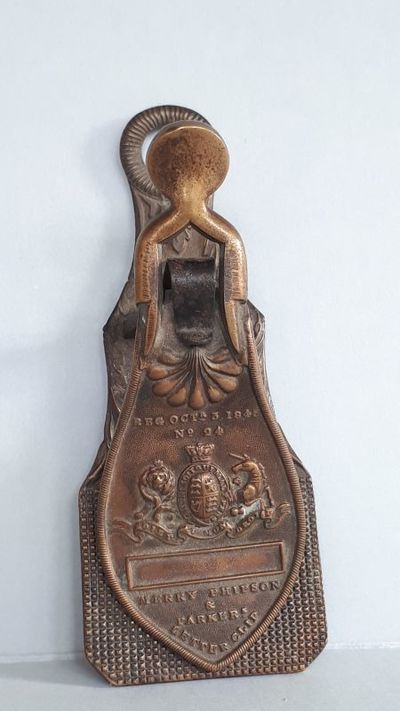
Zettel-Klammer. Letter Clip.
Non-Book Dekoartikel für die Bibliothek 1843. England, 1843. Länge: 12,5 cm. Abriebe de Metalls, sonst ein sehr dekoratives Stück Note clip. Letter clip. Reg Oct 3rd 1843 No 24. Letter clip. England, 1843. Length: 12.5 cm. Abrasion of the metal, otherwise a very decorative piece- $94
- $94
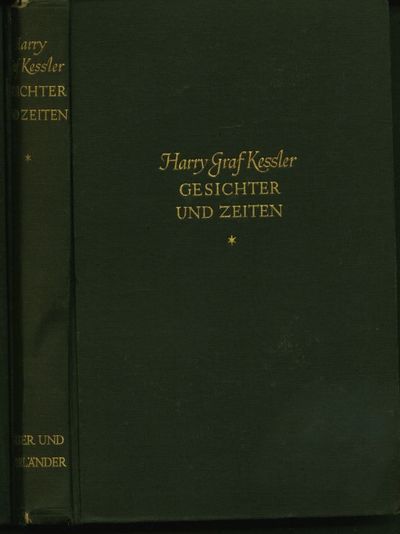
Gesichter und Zeiten. Erinnerungen. Erster Band Völker und Vaterländer.
Kessler, Harry Graf 1935. Berlin, S. Fischer Verlag, 1935. 21,4 x 13,5 cm. 311 (3) Seiten, Frontispiz, 13 Tafeln. Original-Leinenband (etwas fleckig, Ecken und Kanten berieben und bestossen). Oberes Kapitale mit Einriss. Modernes Exlibris. Ordentliches Exemplar der Erstausgabe. Kessler, Harry Graf. Gesichter und Zeiten. Memories. First volume peoples and fatherlands. [All published]. Berlin, S. Fischer Verlag, 1935. 21.4 x 13.5 cm. 311 (3) pages, frontispiece, 13 plates. Original linen binding (somewhat stained, corners and edges rubbed and bumped). Upper capital with tear. Modern bookplate. Decent copy of the first edition.- $120
- $120
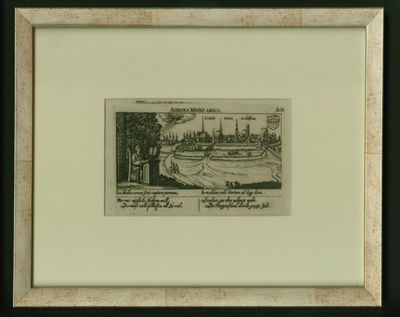
Stade – Original Kupferstich Ansicht aus Nord-Nord-West.
1626. Frankfurt, 1626. 9 x 14,5 cm. Rahmen. Wirtgen/Bohmbach 17. Stade - Original copper engraving view from north-north-west. From: Daniel Meinser and Eberhard Kieser: Political Treasure Chest, Book I Part 8. Erroneous title "Aldenburg in Holstein". Frankfurt, 1626. 9 x 14.5 cm. Frame. Wirtgen / Bohmbach 17th- $201
- $201

Zwei antike Scheren. Ende 19. Jahrhundert. Deutschland, England.
Non-Book Dekoartikel für die Bibliothek Solingen und Sheffield (kleinere Schere). Länge 15 cm , 10 cm. Non-book decorative items for the library. Two antique scissors. Late 19th century. Germany, England. Solingen and Sheffield (smaller scissors). Length 15 cm, 10 cm.- $144
- $144

Deutschlands Kunstschätze. Eine Sammlung der hervorragendsten Bilder der Berliner, Dresdner, Münchner und Wiener Galerien,
1877. 2. Auflage. Bände 1 bis 4. Leipzig, Verlag von A. H. Payne. 1877. 30,2 x 25,5 cm. Band I: 160 Seiten, Tafeln; Band II: 148 Seiten, Tafeln; Band III: 155 Seiten, Tafeln; Band IV: 140 Seiten, Tafeln. Alte private Halblederbände. Berieben, deutliche Alters- und Gebrauchsspuren. Alter Büchergeruch. In späterem Schuber. Germany's art treasures. A collection of the most outstanding pictures of the Berlin, Dresden, Munich and Vienna galleries, with explanatory text by Adolph Görling and a series of portraits of the most important masters with biographical notes by Alfred Woltmann and Bruno Meyer. 2nd Edition. Volumes 1 to 4. Leipzig, Verlag von A. H. Payne. 1877. 30.2 x 25.5 cm. Volume I: 160 pages, tables; Volume II: 148 pages, plates; Volume III: 155 pages, plates; Volume IV: 140 pages, tables. Old private half leather books. Rubbed, signs of age and use. Old book smell. In a later slipcase. 98.00- $119
- $119
Meisterwerke in der Kunsthalle Emden
Sommer, Achim (Herausgeber) 2000. Emden, 2000. 30,5 x 24,5 cm. Band I: 372 Seiten Band II: 351 Seiten, je Band zahlreiche farbige Abbildungen, Original-Pappbände mit farbig illustriertem Schutzumschlag. Modernes Exlibris. Im Original-Schuber. Sommer, Achim (editor). Masterpieces in the Kunsthalle Emden donated by Otto van de Loo. Henri Nannen Collection. Emden, 2000. 30.5 x 24.5 cm. Volume I: 372 pages Volume II: 351 pages, each volume has numerous color illustrations, original cardboard volumes with a colored illustrated dust jacket. Modern bookplate. In the original slipcase.- $65
- $65

Notizen über Mexiko.
Kessler, Harry Graf 1929. Dritte Auflage. Leipzig, Insel-Verlag, 1929. 20,6 x 13,5 cm. 146 Seiten, Original-Leinenband (nachgedunkelt, etwas berieben und bestossen). Modernes Exlibris. Ordentliches Exemplar. Kessler, Harry Graf. Notes on Mexico. Third edition. Leipzig, Insel-Verlag, 1929. 20.6 x 13.5 cm. 146 pages, original linen binding (darkened, somewhat rubbed and bumped). Modern bookplate. Decent copy.- $34
- $34
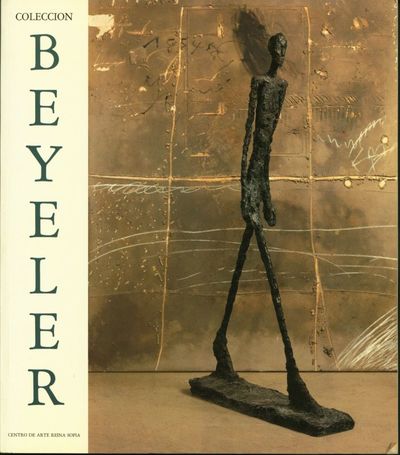
Colección BEYELER.
1989. Madrid, 1989. 30,8 x 27 cm. 229 (1) Seiten, viele farbige Abbildungen, farbig illustrierte Original-Broschur (Ecken leicht bestossen). Modernes Exlibris. Ordentliches Exemplar. Beilagen zum Thema. Colección BEYELER. Introducción y fichas de las obras por Reinhold Hohl. Centro de Arte Reina Sofía 24 Mayo - 24 July 1989. Madrid, 1989. 30.8 x 27 cm. 229 (1) pages, many color illustrations, original colored illustrated brochure (corners slightly bumped). Modern bookplate. Decent copy. Supplements on the subject.- $38
- $38
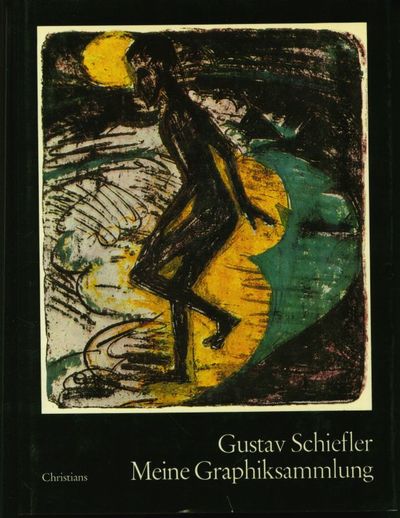
Gustav Schiefler. Meine Graphiksammlung.
Schack, G. (Herausgeber) 1974. Hamburg, Christians Verlag, 1974. 26,3 x 19,3 cm. 338 Seiten, zahlreiche, teils farbige Abbildungen. Original-Pappband mit farbig illustriertem Schutzumschlag (kleine Randeinrisse). Beiliegend Verlagsprospekt zum Buch. Modernes Exlibris. Sonst ein gutes Exemplar. Schack, G. (Editor). Gustav Schiefler. My collection of graphics. Hamburg, Christians Verlag, 1974. 26.3 x 19.3 cm. 338 pages, numerous, partly colored illustrations. Original cardboard tape with a colored illustrated dust jacket (small tears in the edge). Enclosed publisher's brochure for the book. Modern bookplate. Otherwise a good copy.- $31
- $31
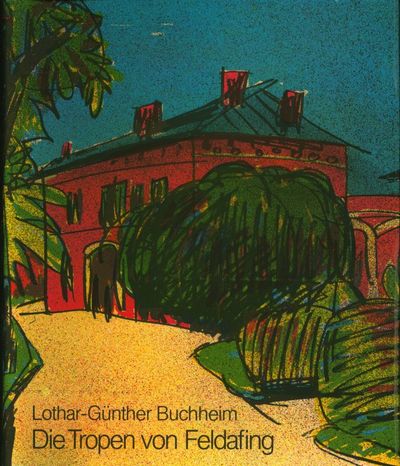
Die Tropen von Feldafing. Mit einem Nachwort von Herbert Pée.
Buchheim, Lothar-Günther 1978. München-Zürich, R. Piper & Co., 1978. 30 x 25 cm. 132 (4) Seiten, Abbildungen. Farbige Original-Folien-Lithographie "Der Bahnhof in Feldafing" als Schutzumschlag. Die der Luxusausgabe beigelegte Original-Lithographie schön gerahmt. Im Druckvermerk nummeriert und von Buchheim signiert. Die Lithographie ebenfalls nummeriert und signiert. Modernes Exlibris auf der Innenseite des Vorderdeckels montiert, sonst ein gutes Exemplar. Buchheim, Lothar-Günther. The tropics of Feldafing. With an afterword by Herbert Pée. Luxury edition, one of 250 copies. Munich-Zurich, R. Piper & Co., 1978. 30 x 25 cm. 132 (4) pages, illustrations. Original colored foil lithograph "Der Bahnhof in Feldafing" as a dust jacket. The original lithograph enclosed with the luxury edition is nicely framed. Numbered in publisher's note and signed by Buchheim. The lithograph also numbered and signed. Modern bookplate mounted on the inside of the front cover, otherwise a good copy.- $817
- $817
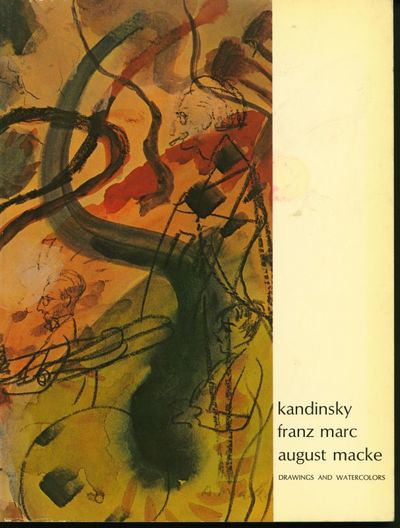
kandinsky franz marc august macke.
1969. 1969. 28,4 x 21,5 cm. 129 Seiten, zahlreiche farbige Abbildungen. Farbig illustrierte Original-Broschur (etwas fleckig, berieben). Modernes Exlibris. kandinsky franz marc august macke. Drawings and watercolors. Exhibition april 16-may 28, 1969 Hutton-Hutschnecker Gallery inc. 967 Madison Avenue New York. 1969. 28.4 x 21.5 cm. 129 pages, numerous color illustrations. Original colored illustrated brochure (somewhat stained, rubbed).- $94
- $94
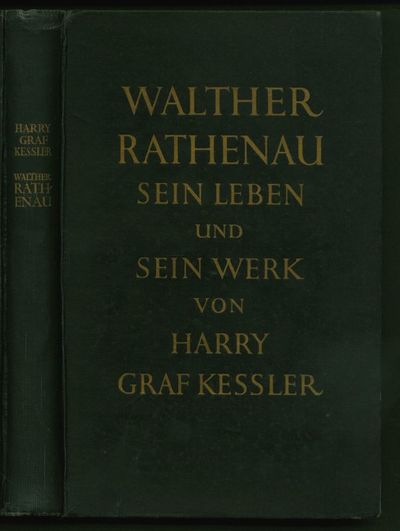
Walther Rathenau. Sein Leben und sein Werk.
Kessler, Harry Graf 1928. 6.-10. Tausend. Berlin-Grunewald, Verlagsanstalt Hermann Klemm A. G., 1928. 23,2 x 15 cm. 389 (1) Seiten, Tafeln. Original-Leinenband (fleckig, Ecken und Kanten berieben und bestossen). Modernes Exlibris. Insgesamt ein ordentliches Exemplar. Kessler, Harry Graf. Walther Rathenau. His life and his work. With thirty-two illustrations in rotogravure. 6-10 Thousand. Berlin-Grunewald, Hermann Klemm A. G. Publishing House, 1928. 23.2 x 15 cm. 389 (1) pages, tables. Original linen binding (stained, corners and edges rubbed and bumped). Modern bookplate. Overall a decent copy.- $70
- $70
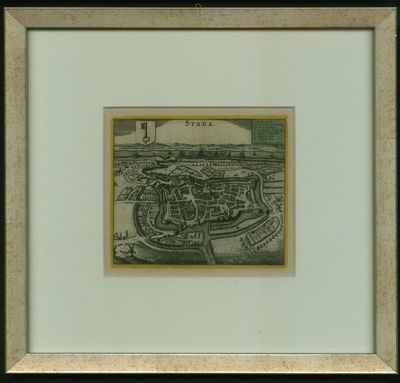
Stade – Ansicht aus der Vogelschau von Westen. Kupferstich von Zeiller-Janssonius.
1658. 11 x 13 cm. Eräuterungen oben rechts. Rand-koloriert. Rahmen. Variante zu Wirtgen/Bohmbach 25. Selten. Stade - bird's eye view from the west. Engraving by Zeiller-Janssonius. 1658. 11 x 13 cm. Explanations at the top right. Edge colored. Frame. Variant to Wirtgen / Bohmbach 25. Rare.- $541
- $541
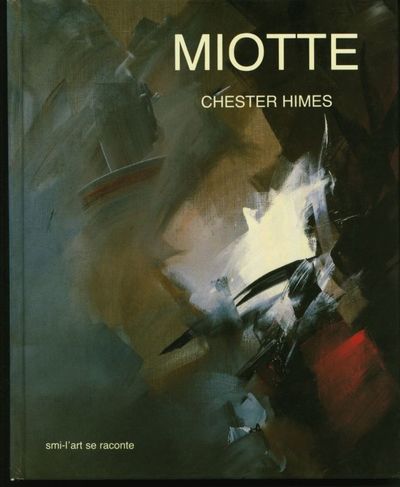
MIOTTE.
Himes, Chester 1987. Paris, SMI, 1987. 26 x 21,2 cm. 131 (1) Seiten, zahlreiche, teils farbige Abbildungen. Farbig illustrierter Original-Pappband. Modernes Exlibris. Gutes Exemplar. Beilagen zum Thema. Himes, Chester. MIOTTE. smi-l'art se raconte. Paris, SMI, 1987. 26 x 21.2 cm. 131 (1) pages, numerous, partly colored illustrations. Original color illustrated cardboard binding. Modern bookplate. Good copy. Supplements on the subject.- $94
- $94
The Tale of Peter Rabbit.: https://rarebookinsider.com/rare-books/the-tale-of-peter-rabbit/
